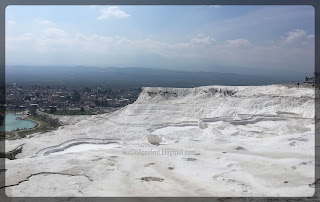The Harem Apartments include over 400 rooms as the sultan was allowed up to four wives. The word harem, despite the connotations of the word when used today, actually means "forbidden". My understanding is the there was no limit on the number of concubines the sultan could have and I think the concubines were slaves. If they were lucky they might become a wife, but seeing as the number of wives was limited, the chances were not good. The mother of the first born son had the highest status and therefore had the largest rooms in the palace. The eunuchs were the bodyguards for the harem and had their own section inside the harem. Oddly enough, Turkey has the world's 3rd largest collection of Chinese Porcelain (China and Germany hold 1st and 2nd place).
From the palace we walked to the Basilica Cistern, the largest of the hundreds that lie beneath the city. Built about 500ft from the Hagia Sofia by the Byzantine Emperor Justinian I (also known as Justinian the Great). It is estimated to hold 100,000 tons of water sourced from the Belgrad Forest, about 19km (12 miles) from the city. This cistern has 2 Medusa heads and many beautiful Roman columns. I found it so odd that they bothered making such beautiful columns inside something never meant to be seen, let alone visited by tourists! Later research enlightened me: many of the columns were recycled from the ruins of other buildings. The most famous thing about this particular cistern (apart from its size) is the aforementioned Medusa heads. The Atlas Obscura entry sums it up quite nicely, "The two giant Gorgon-head pillar bases at the far end of the cistern are an intriguing mystery. It is suspected that they may have been pulled out of an older pagan temple, where motifs of the famous Gorgon Medusa were used as a protective emblem. It is possible that the placement of these two faces — upside down and sideways, at the base of pillars — may have been a deliberate display of the power of the new Christian Empire. Or it’s possible that the stones were just the right size."
 |
| Hard to take photos down there... |
Our final stop of the day was to the famous Grand Bazaar. Oh my goodness, what a maze! I honestly don't know how the shop keepers ever find their stores - there are over 4,000 shops! It is one of the oldest and largest covered markets in the world. As Rick Steve explains, "Sprawling over a huge area in the city center, Kapali Çarsi ("Covered Market") was the first shopping mall ever built. During Byzantine times, this was the site of a bustling market; when the Ottomans arrived, it grew bigger and more diverse. The prime location attracted guilds, manufacturers, and traders, and it grew quickly — its separate chunks were eventually connected and roofed to form a single market hall. Before long, the Grand Bazaar became the center for trade in the entire Ottoman Empire. At its prime, the market was locked down and guarded by more than a hundred soldiers every night, like a fortified castle."
Fittingly, we entered (and therefore needed to exit once finished) through Gate 1 (which is the name of our tour company). Serdar assured us that if we simply asked for directions back to the Main Street (once once found themselves completely lost) and once there simply walk in the direction of the descending numbers and we'd find ourselves back where we started. These days there are apps and special maps to find your way around, but even someone as directionally-challenged as myself was able to manage with those instructions as my guide. I wandered around the Grand Bazaar by myself the whole time and although the reputation of the aggressive shop keepers is true (and the vast majority are male) I never felt threatened or uncomfortable. To be fair, I'm told I give off a no-nonsense vibe, so that might have tipped the scale in my favor.
You're supposed to haggle with the shop keepers, but I'm incapable. It's just not in my blood. With a recent sermon on consumerism on my mind, I didn't end up buying any souvenirs. I looked at a lot of beautiful pottery and scarves, but at the end of the day my suitcase was already full and I had absolutely no need for more items. Couple that with my inability to haggle and the only thing I purchased was some Turkish Delight for my family and coworkers to try when I got home (and yes, I paid full price). On our bus ride this morning Serdar mentioned that Turkey is quite popular with Medical Tourism. Based on the number of men I saw at the Grand Bazaar with bandages and scabs on their heads it would seem that hair transplants are quite popular.
We returned to our hotel (where I think I might have been upgraded to a suite or something - the room was amazing) and then enjoyed a lovely farewell dinner with my tour-mates. A fantastic trip and a nice way to end our tour together.





















































